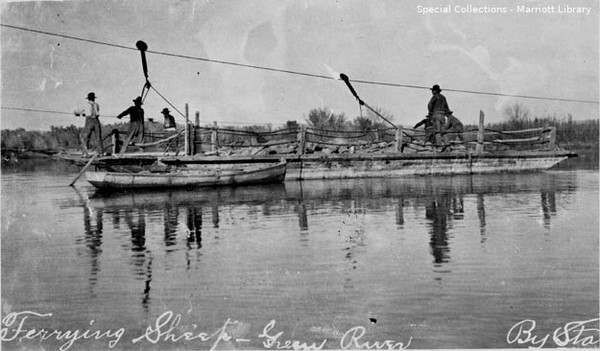Dublin Core
Title
Description
In the arid West, water is a force for both division and connection. The deep canyons of the Green River have barred human travel for thousands of years. One of the few natural crossing points is the 10-mile stretch of water at the modern-day town of Green River.
This crossing was settled in 1878 as a postal station along the Overland Mail route. Called “Blake” after the man who ran it, the station became a stop on the new Denver & Rio Grande Railroad in 1883. Aside from the railroad bridge, for the next 30 years, the only way to transport people and goods across the river was a ferry service. A wagon bridge finally replaced the ferry in 1910. When the bridge collapsed in 1946, the disruption was dramatic on both sides of the river. On the west, traffic was diverted far north through Duchesne, while farms on the east could not get their melons to market. Even today, that re-built bridge and adjacent I-70 remain the only crossings of the Green River for hundreds of miles.
As well as a barrier to travel, the Green River forms the dividing line between Emery and Grand counties. At the crossing, the town of Blake sat on the east bank and Elgin on the west. By 1917, the river bed had shifted about a mile and resulted in a prolonged court battle between the counties. Yet the close proximity of Blake and Elgin had forged a single community at the old Green River crossing, unifying residents through their connections to the river. Together, they had built diversion dams and canals to irrigate their farms. Residents on both sides relied on the river for water supplies. And everyone enjoyed water recreation. For over 50 years, the town hosted the annual Friendship Cruise that brought boaters together to celebrate their love for the river.
No longer divided, the town at the old Green River crossing is one community spanning both sides of its namesake waterway, and is the heart of a region centered on the river.
Creator
Source
_______________
See John Wesley Powell River History Museum, exhibition file for “Our River is Our Community,” curated by Kelsie Hart, 2020; Richard A. Firmage, A History of Grand County (Salt Lake City: Grand County and Utah State Historical Society, 1996); Edward A. Geary, A History of Emery County (Salt Lake City: Utah State Historical Society and Emery County Commission, 1996); and Muriel W. Smith, They Were Here : Stories and Statistics of the People of Elgin, Utah & Green River, Utah (Green River, Utah, 2005).

